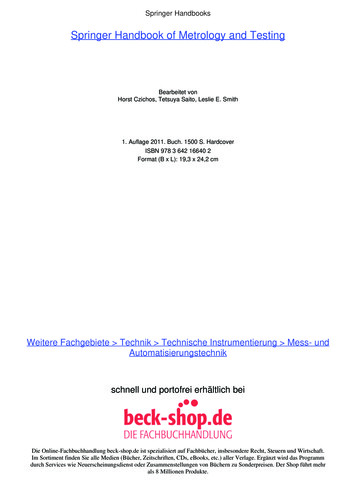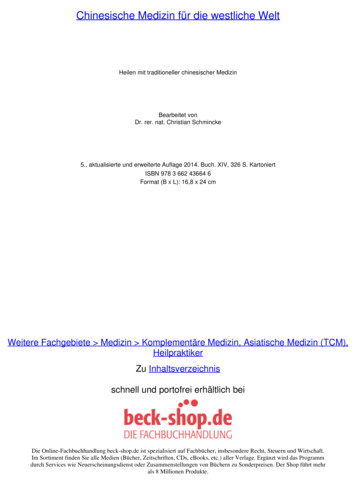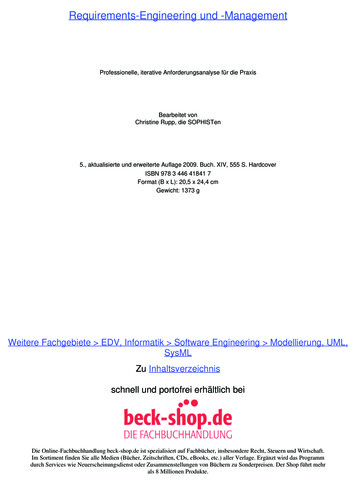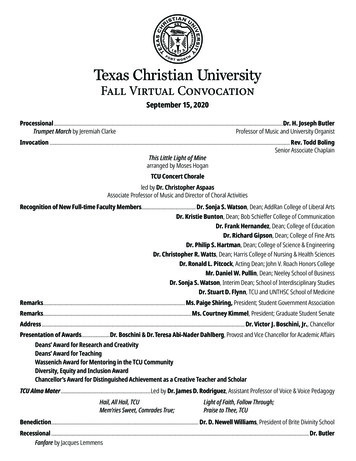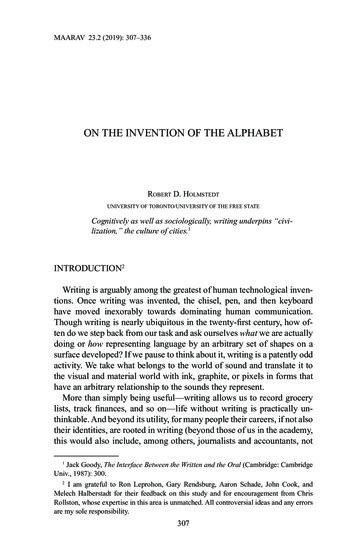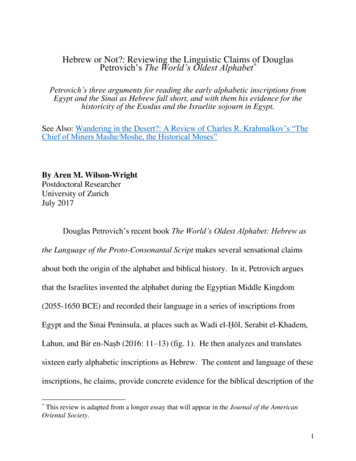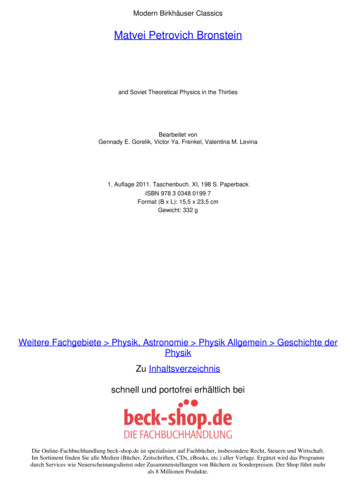
Transcription
Modern Birkhäuser ClassicsMatvei Petrovich Bronsteinand Soviet Theoretical Physics in the ThirtiesBearbeitet vonGennady E. Gorelik, Victor Ya. Frenkel, Valentina M. Levina1. Auflage 2011. Taschenbuch. XI, 198 S. PaperbackISBN 978 3 0348 0199 7Format (B x L): 15,5 x 23,5 cmGewicht: 332 gWeitere Fachgebiete Physik, Astronomie Physik Allgemein Geschichte derPhysikZu Inhaltsverzeichnisschnell und portofrei erhältlich beiDie Online-Fachbuchhandlung beck-shop.de ist spezialisiert auf Fachbücher, insbesondere Recht, Steuern und Wirtschaft.Im Sortiment finden Sie alle Medien (Bücher, Zeitschriften, CDs, eBooks, etc.) aller Verlage. Ergänzt wird das Programmdurch Services wie Neuerscheinungsdienst oder Zusammenstellungen von Büchern zu Sonderpreisen. Der Shop führt mehrals 8 Millionen Produkte.
19Chapter 2In Leningrad University (1926-1930)2.1 Entering the UniversityLeningrad was the USSR's scientific capital, housing the Academy of Sciences andthe main academic institutes until 1934. It was there that Bronstein became aphysicist. Even though he was the author of several scientific papers, he still had toget a university diploma. One can imagine that. having been educated at home hewas not over-enthusiastic about the prospect of studying according to officialprograms. No doubt he was aware of the gaps in his knowledge- after all, study isthe major element in the theoretician's trade, yet at 19, Bronstein felt older thanmost of his fellow students. At the same time he could not but profit from being partof the physicists' community.At that time, Leningrad boasted two higher educational establishments thatoffered a sound training in physics: the Polytechnical Institute with its Departmentof Physics and Mechanics and the university. The former, set up by Ioffe some sevenyear before, provided close ties between physics and technology. However, thetraining program included a wide range of engineering subjects and technologicaldisciplines that a theoretician could have considered an unnecessary burden.Theoreticians were produced by the University despite it was a pretty old-fashioned.There were no famous scientists on its teaching staff (with the exception of D.Rozhdestvensky who was an experimenter). This was rooted in the past, whenPetersburg University was inferior to Moscow University with its cluster of celebrities (A. Stoletov, A. Eikhenvald, P. Lebedev). Between 1907 and 1912 PaulEhrenfest had managed to raise the level of Petersburg physics but in the twentiesits teaching staff comprised mostly educators rather than researchers; Orest Khvolson (1852-1934) was one of them. He had written a definitive Course of Physicsthat was favorably accepted abroad (Einstein praised it and Fermi studied it).Though not young, he enthusiastically acclaimed the revolutionary theory of relativity and quantum physics.Being a man of wide-flung interests, Bronstein was evidently attracted by thevariety of subjects taught under one university roof: astronomy and philology,history and mathematics.In 1926 Bronstein passed the entrance exams, 1 which probably presented nodifficulties. Very soon he became a local celebrity with scientific papers in the bestEuropean physical journals to his name. His teachers were cautious not to becomeentangled in scientific discussions with him. He was known for his ability to passG.E. Gorelik and V.Y. Frenkel, Matvei Petrovich Bronstein: and Soviet Theoretical Physicsin the Thirties, Modern Birkhäuser Classics, DOI 10.1007/978-3-0348-0200-0 2, Springer Basel AG 2011
20Chapter 2In Leningrad University (1926-1930)any exam without much difficulty: early in November he went to Professor Khvolson to sit for an exam in general physics. Khvolson responded with: "You can't beserious, dear sir. The other day I read your article in Zeitschrift fur Physik. It's notfor you to sit for an exam in physics! Give me your record book". A week later hepassed his exam in mathematics for the first year. His record book contained alsosignatures ofV. Bursian, Y. Krutkov, P. Lukirsky, V. Pock, V. Frederiks [100].Though he obviously could have finished his studies earlier he spent four yearsat the university. It seems that he considered the university a favorable milieu.Studies were by no means his main occupation during these years: it was at this timethat he obtained some significant results in astrophysics that later (when academicdegrees were reintroduced) earned him a degree of candidate of science without theusual procedure of defending a thesis.It is very important for a young theoretician to have friends with whom he candiscuss his ideas: young scientists tend to form rather stable groups of similarlyminded people. In the spring of 1927 Bronstein was lucky enough to stumble acrossone such group, which he immediately joined. Significantly enough, it was poetry,rather than physics, that helped him.2.2. The Jazz-BandThe group Bronstein joined was the famous Jazz-band, formed around GeorgeGamow, Dmitry Ivanenko and Lev Landau 2 , better known by their nicknames ofJonny, Dymus and Dau. They were called "the three musketeers". Some physicistsand philosophers found it hard to follow the rapidly unfolding developments inphysics and got polite indifference and littler respect from the "three musketeers".They reciprocated by calling them a "Jazz-gang".Bronstein joined this musketeer group easily and naturally and faithfully servedits royal majesty, physics.Here is how Lady Peierls ( 1908-1986) described Bronstein's first encounter withthe Jazz-band in a letter she sent to us on March 9, 1984. (She was ZhenyaKanegisser before when she married Rudolf Peierls in 1931, a German physicistwhom she met at the Odessa physical congress. He was knighted for his scientificachievements, part of which could be attributed to his charming, optimistic andintelligent wife. After the spring 1926, when she joined the Jazz-band, she wrotemuch of its poetry.)I'll do my best to describe everything I remember of Matvei Bronstein. I first met him in earlyspring 1927. There were puddles everywhere, sparrows were chirping in a warm wind. Onemerging from a laboratory on the Vasiliev Island I quoted a line from Gumilev to a young manwho happened to pass by. He was not tall, wore large glasses and had a head of fine nicely croppeddark hair. Unexpectedly, he responded with a longer quotation from the same poem. I was
2.2. The Jazz-Band21delighted; we walked side by side to the University quoting our favorite poems. To my amazementMatvei recited The Blue Star by Gumilev which I had no chance of reading.At the University I rushed to Dymus and Jonny to tell to them about my new friend who knew allour favorite poems by heart and could recite The Blue Star.That was how Matvei joined the Jazz-band. We were putting out the Physikalische Dummheitenand read it at university seminars. In general, we sharpened our sense of humor on our teachersand at their expense. I should say that by that time Joe, Dymus and Dau had left all others farbehi'nd where physics was concerned. They explained to us all the new and amazing advances inquantum mechanics. Being a capable mathematician the Abbot (Matvei Bronstein) was able tocatch up with them quickly.I can visualize Matvei with his specs slipping down his nose. He was an exceptionally "civilized"and considerate person (a rare quality in a still very young man); he not only read a lot but alsohad the habit of thinking a lot. He accepted no compromises when his friends "misbehaved".I cannot say who gave him his nickname, which suited him perfectly: he was benign in hisskepticism, appreciated humor and was endowed with universal "understanding". He was exceptionally gifted.This is an ample illustration of the intensity with which the Jazz-band treated life.They had a seminar of their own at which they heatedly discussed events in physicsand everything else under the sun: ballet and poetry, Freudism and the relations ofthe sexes were subjected to scathing and dissecting theoretical analysis. Here is anillustration of the tense atmosphere in theoretical physics put into verse by ZhenyaKanegisser who used Gumilev's The Captains as her model:You all are the paladins of the Green Temple,All leading your way through de Broglie's wavesThe Earl Frederiks and Georgy de Gamow,Who questioned the ether with nothing to save,Landau, Ivanenko, two boisterous brothers,Krutkov, the indifferent CTP's head,And Frenkel, the general of Rontgen armyWho made the electron dance and spin,The brilliant Fock, Bursian, Finkelstein,And tiniest crowds of studying youths,You started your voyage to follow EinsteinWho taught you to scorn the traditional rules.Though Heisenberg's theories weren't a triumph,And Born's hard-earned laurels seemed withered a bit,Yet Pauli's principle, Bose's statisticsHave long won your hearts, and your minds, and your wit.The Nature is still enigmatic and hidden,You still do not know all the secrets of light,The nuclear laws still remain undiscovered,And you are now trying to conquer the blight.
22Chapter 2 In Leningrad University (1926-1930)When reading your cleverest papers in Zeitschrift,With all our problems becoming more vague,The only delight is the thought that BotheWill give you all guys a proper spank.Here some explanations are needed - Y. Krutkov, who headed the Cabinet ofTheoretical Physics, was not an overenthusiastic chief; Bothe's and Geiger's experiments deprived Bohr's non-conservation hypothesis in the Compton scatteringof any grounds. This hymn was probably written in 1926. It appeared in thePhysikalische Dummheiten (Physical Absurdities) that ridiculed tempestuousevents around physics, sometimes with friendly irony and often with biting sarcasm.The editors themselves were not exempt.The same could be said about the Jazz-band's relationships with their elders. Thevery name was a gauntlet thrown to public opinion: in the Soviet Union jazz wasaccepted in the late twenties. One of the scientific papers [ 156] was written jointlyby Gamow, Ivanenko and Landau to honor one of the Jazz-band girls in the Astoriarestaurant (where the university students had their meals for a token sum due to theefforts of the Commission for Improving the Life of Students).Despite a somewhat frivolous reason, the article deserves a closer look whichwe offer below. No matter how talented the Jazz-band leaders could not create apaper from a restaurant atmosphere; obviously it was based on everyday discussionsand ideas voiced by the entire Band. They offered no formalized substantiation and,therefore, they could not regard the results as belonging completely to physics. Inall other respects it was a physical article that reflected the contemporary state offundamental theoretical physics and even offered some glimpses of the future. InChapter 5 we shall discuss it in greater detail and wonder why Bronstein was notamong the authors.2.3. The Abbot and His Astronomer FriendsNo wonder E. Peierls did not know who had given Bronstein his nickname of theAbbot: it was given by another group he was close with during his student years, agroup of astronomers.At Leningrad University, astronomers belonged to the department of mechanicsand mathematics, rather than physics. This was rooted in the past, when theoreticalastronomy rested on a single arm of celestial mechanics.Throughout history, the relationship between physics, astronomy and mathematics went through different stages. In antiquity, "physics" was the name of allsciences about nature; the obvious regularity of astronomical phenomena was takenas the model of all natural laws. Being mathematically precise, this regularity was
2.3. The Abbot and His Astronomer Friends23an abyss between celestial physics, guiding the heavens, and earthly physics,struggling to put some sense and order into the chaos of the phenomena on Earth.In the Newtonian age, new physics, new mathematics and new astronomy wereborn; Mitya Bronstein was first introduced to this remarkable time through Flammarion's Astronomy for Everyone. Newtonian physics declared that its laws werevalid for the entire Universe, with celestial mechanics- the natural base for theoretical astronomy- being nothing more than a particular case of physics. Later, however,celestial mechanics became merely a part of mathematics. While astronomy restedon celestial mechanics, the students of astronomy were natural members of thedepartment of mathematics and mechanics. True, they had to describe the movementsof celestial bodies as motion of material points rather than physical bodies.In the mid-nineteenth century spectral analysis as applied to the study of starschanged the situation. However, the union of physics and astronomy was finallysealed by quantum theory, which decoded the enigma of spectral lines. This openednew vistas for astronomy - astrophysics came of age in the second half of thetwenties [234].Any physicist who closely followed advances in natural science could neverhave missed astrophysics' heyday. The tree of astronomy was blossoming with theflowers of physics; astronomical numbers were turning into physical numbers.Bronstein was such a physicist- while in Kiev he was fascinated by astronomy.No wonder then that at the university he attended lectures on astronomy. He quicklymade friends among the students of astronomy: V. Ambartsumyan and N. Kozyrev;he was also friendly with I. Kibei, I.A., who studied hydromechanics. They dividedtheir time between the university and the Pulkovo Astronomical Observatory.What was more, Bronstein introduced his physicist friends to astronomy. Whenwriting about Ambartsumyan and Kozyrev's early papers on stellar atmospheres,D. Martynov recalled that both had been members "of a talented group of studentsthat was formed at Leningrad University in the twenties. It also comprised M.Bronstein, G. Gam ow, L. Landau and D. Ivanenko- a veritable constellation of thefuture stars of the first magnitude! Bronstein and Ivanenko used to come frequentlyto Pulkovo to take part in free discussions of widely varied questions of theoreticalphysics and astrophysics that later gave birth to some significant papers. With hisjet-black hair, the reserved, balanced, highly logical and convincing Bronstein wasa decided contrast to Ivanenko, who was spontaneous and noisy and who spokeeasily and fluently. He obviously knew what he was talking about; his mind wasalways brimming with barely formulated ideas. At that time, Bronstein had recentlysolved several important questions of the theory of radiation transfer in the atmospheres of the Sun and stars, while I vanenko and Ambartsumyan had finished severalpapers on mathematical physics and the physics of the nucleus. It was during thatperiod that Landau touched on some astrophysical problems - the result was hispaper on the possibility of superdense stars that appeared in 1932 [234, p. 440].
24Chapter 2 In Leningrad University (1926-1930)In fact, the change of generations in astronomy was even more dramatic than inphysics: the older generation was struggling under a double impact of physics andthe new relativist and quantum ideas physicists themselves were just getting usedto. Important observational facts were discovered. In particular, it was establishedthat the spiral nebulae were other galaxies. This made the astronomical picture ofthe universe much wider than had been earlier believed. It was primarily youngpeople who were introducing young physical ideas into astronomy; naturallyenough, the older generation was distrustful of the attempts of their youngercolleagues "to determine the number of atoms above each square inch of the Sun'ssurface" [234, p. 439]. They were shaken by the avalanche of new facts and ideas.One day there appeared a notice at the department of astronomy informing thoseinterested that M. Bronstein would read a survey of works by Bodichiraka Ramasatva, a prominent Indian physicist and astrophysicist, who, on visit to Leningrad,had kindly submitted his unpublished paper to them.The lecture hall was filled to capacity - Bronstein had already earned thereputation of a brilliant lecturer. Having presented the basic assumptions, heformulated a problem for a planetary system's proper values. He chalked animposing differential equation that contained Planck's constant, the velocity oflight, the electron mass, the mass of the central luminary and a cluster of Latin andGreek letters. Bronstein discussed the wave function behavior and presented a rangeof proper values. Then he made certain transformations and inserted the mass of theSun. At this point the audience recognized the famous Titius-Bode relation thatdetermined the actual mean distance of a planet from the Sun. This was the mainconclusion of the paper.The audience was duly impressed. Speaking on behalf of it, Professor P. Gorshkov voiced his favorable opinion of"this extremely interesting paper" and offeredhis opinion on certain points.The mysterious presentation was a complete success: it was revealed to theaudience's laughter and to the great delight of the practical jokers.The paper was read at the Astronomical Cabinet, the usual place for all lecturesand discussions in astronomy. In 1927-1928 the students of astronomy put out ajournal predictably called Astrocabical Journal that was very much like its cousinPhysikalische Dummheiten. The titles reflected the state of affairs in contemporaryphysics dominated by the Germans and contemporary astronomy dominated by theBritish.V. Ambartsumyan quoted a sonnet Bronstein had dedicated to the AstrocabicalJournal:I wish you be above critiques and praises,I wish you be a beacon in the dark,And like the sun you shine in all your phrases,I wish you all the best, my newly born Zhurnal!
2.3. The Abbot and His Astronomer Friends25I know that circulation is but tiny;Your fate was thought to be a lucky oneWhen maniacal Kostinsky3 was tryingTo get and copy you for his scientific scum.Your origin is rather enigmatic,The efforts to reveal them are pathetic.Your parents are unknown to everybody,Your secret guards are mystery to all.And once appointed they are always silentLike priests of Dionysia of the old.The young Leningrad astronomers were no less fond of nicknames than the physicists. More likely than not, these nicknames were derived from first names or familynames: Ambarts for Ambartsumyan, Kib, Dau, Jonny, Dymus. Bronstein's nickname was of a different origin.It was taken from a book by Anatole France At the Sign of the Reine Redauque,translated into Russian by I. Mandelstam, Zhenya and Nina Kanegisser's stepfather;their home was the favorite haunt of young physicists and astronomers.The young astrophysicists read the book out aloud while commuting to Pulkovo;evidently they were greatly impressed by Abbot Jerome Coiquard, doctor of theology and magister of sciences, and found many of his remarkable features inBronstein: profound mind, wide knowledge, balanced skepticism, kindheartednessand tolerance. According to Ambartsumyan, Kozyrev was the first to apply thisname to Bronstein, the scope of whose knowledge struck them most.The abbot's devoted pupil was convinced that "no geometers and philosopherswho, emulating M. des Cartes, were able to measure and weight the worlds couldrival [his] teacher in talent and knowledge". It seems that Bronstein's friends foundin him a true rival for the abbot, since in the twentieth century it was a privilege ofphysicists to measure and weigh the world.Just like the fictional character Bronstein could not leave a book unread- he hadread an awful lot of them. While it took Coiquard 51 years "to read all the Greekand Roman authors graced by time and human ignorance" it took Bronstein only 21years to earn this honor.As could be expected, a French theologian of the early Enlightenment and aSoviet physicist of the early socialist period were not identical: while the abbot wasfond of his bottle, his food and other earthly delights, Bronstein was much moremoderate - hence all contradictory explanations of how he got his nickname.One should not imagine, however, that Matvei was engrossed in books andscience to the exclusion of everything else. He and his friends were very much likeother young people. Numerous photos of that time bear witness to this. In one ofthem the Abbot is holding a large cross. He is obviously converting Zhenya, who is
26Chapter 2 In Leningrad University (1926-1930)kneeling in front of him; Ambartsumyan is nearby with a suitcase. It seems that hewas posing as one of the traders who invariably followed missionaries to newlyconverted countries. In another photo there is a bespectacled young lady, modestlycovered with a shawl, flanked by two young men. The "lady" is Matvei, and his twosweethearts are the Kanegisser sisters. Another photo was taken in Odessa duringthe 1930 Physical Congress. Young physicists in bathing trunks are holding laughing girls in swimsuits by their heels.Late in the summer of 1929 Ambartsumyan, Bronstein, Kozyrev and Kibeitravelled across Armenia to Ambartsumyan's home village. It took them slightlymore than a week, during which they passed through a storm on Lake Sevan withwaves of oceanic dimensions, rode in the mountains, spent a night in the open withhorror stories told by turn and walked forty kilometers on foot. Being not very strongBronstein had to mobilize all his inner resources, yet the main goal was attained:they distracted themselves completely from their intensive studies and scientificresearch.2.4. The First Works in Astrophysics, Geophysics andPopular ScienceBronstein worked a lot in 1929 and achieved a lot: he wrote two papers onastrophysics, one on geophysics, his first popular science book and several articles.Indeed, one cannot expect more of a student!His first astrophysical papers dealt with stellar atmosphere. Ambartsumyan andKozyrev were working in the same field; this was the period when physics discovered a totally new object -the star as an integral physical system. To solve themain riddle- the star's internal structure and its energy source- one has to form anidea about its surface and the atmosphere that connects it with the outer world andthe observer as a part. Without this, no in-depth studies were possible. On the otherhand, while physics itself had advanced to the point where it could tackle theproblems of the atmosphere, it had not advanced enough to look inside the stars.The theory of stellar atmosphere had been developed enough to allow easysuccess for a chance intruder. It boasted of own masters such as K. Schwarzschild,J. Jeans, A. Eddington and E. Milne.The problem of the radiation equilibrium of stellar atmosphere goes back toSchwarzschild. Astrophysics define stars (the Sun included) by the effectivetemperature Teff the temperature of the black body of the same dimensions and thefull radiation equal to any given star. Its value is calculated by observations on Earth.Bronstein set himself the task of defining the dependence of the temperature of the
2.4. The First Works in Astrophysics, Geophysics and Popular Science27stellar matter on the (optical) depth 'T within the framework of the star's definitephysical model. It had been established by that time that the dependence waswhere the value of q( r) differed little and was established through the solution of adefinite integral equation (Milne's equation). It was obvious that the numericalvalue q(O) allowed one to determine the exact temperature of the solar surface T 0 ,through the value of Teff that could be measured on Earth. The best minds inastrophysics coped unsuccessfully to determine the exact value of q(O). The resultwas several approximations -Jeans and Eddington produced two each and threebelonged to Milne. It was Bronstein who in 1929 offered the exact value for q(O) 3- 1/ 2 and, consequently, the exact correlation(This result became known as the Hopf-Bronstein correlation [297, pp. 85, 96]although the order of the names should have been different since Hopf arrived atthe same result later. 4 )The high level of Bronstein's first astrophysical papers is attested to by the factthat they appeared in major scientific journals. The third (and last) article on thestellar atmospheres was published in the Monthly Notices (Great Britain) on Milne'srecommendation. It was an answer to a letter from Milne. It seems that he wasgreatly impressed by Bronstein's exact result and hastened to toss him anotherchallenge- the boundary value of q( ) (the infinite optical depth in the star'satmosphere corresponds to an insignificant actual geometrical depth). No exactresult was obtained (and it has not been obtained so far), but Bronstein was able toproduce certain approximations. 5These papers belonged to mathematical physics; he skillfully applied mathematics to resolve the already posed physical problems: there mathematics was notinvolved at the expense of physics. (Practically the same mathematical apparatuswas invoked in the late thirties and forties to describe the transfer of neutrons inuranium).We shall not discuss these works in detail here: every researcher is aware thattime is harder on the creations of scientists than on artistic creations. This isespecially true of theoretical physics. Even the most revolutionary ideas and worksare preserved for posterity only as several lines and formulae in textbooks anddefinitve monographs. One or two sentences designed to educate a new generationor to express the author's emotional attitude to the results sum up a long and
28Chapter 2 In Leningrad University (1926-1930)torturous path, painful efforts to overcome real and imagined obstacles, delusionsand errors. Yet smallernothing remains of the uninterrupted flow of good or evenexcellent works. Only historian of science knows that they are needed to set up afavourable environment outside which no spectacular achievements are possible.The high level of Bronstein's contribution to astrophysics was demonstrated bythe 1934 granting of the newly introduced academic degree of Candidate of Sciencesbypassing the usual procedure of defending the thesis. He also wrote articles onwhite dwarfs and on the influence of electron-positron pairs in the thermal equilibrium under high (stellar) energy densities (see Section 5.2).In 1929 Bronstein turned to geophysics. Although the title of his large article [8]also contained the word "atmosphere", like his works in astrophysics this was apurely linguistic coincidence since the stellar and earth atmospheres are completelydifferent spheres of research. The different physical conditions in them poseddifferent physical problems: anybody probing the stellar atmosphere had to studythe mean steady-state conditions that determined the star's temperature. The mostimportant problems of the Earth's atmosphere are connected with its dynamics.Eddington was right when he said that a star was basically an simple research objectthat posed fewer riddles than man. One could say that the atmosphere of the Earthcompares with man where its complexity is concerned: it is not for nothing thatweather forecasts, supposedly based on atmospheric dynamics so far remain unreliable. It is as difficult to forecast weather as it is to guess how a man will behaveunder specific circumstances.Bronstein introduced his article on the atmospheric dynamic with an epigraphfrom E. Kummer: "A certain degree of approximation can make a cobblestone anellipsoid". This was a natl!ral reaction of a physicist-theorist to theoretical geophysics. In general, theory can be applied only to comparatively simple models whilethe Earth, the main geophysical object, is far removed from the geophysicaltheoretical models- farther than is allowed in theoretical physics.Bronstein was far from condescending to geophysics. In fact, his first popularscience book, Composition and Structure of the Earth, is a good example of hisprofound knowledge of geochemistry, geophysics and seismology, unexpected in aspecialist in theoretical physics, who one year later produced an article on quantization in the magnetic field and a detailed cosmological survey. In his book hepresented vast observational material and discussed hypotheses that had nothing incommon with theoretical physics, such as Wegener's hypothesis on continental drift.One cannot but wonder how he was able to combine these far-flung fields astrophysics, geophysics and fundamental physics. His varied scientific interestsamazed his friends as well.One reason for this can be found in his personal files, which show that in July1929, while a student, he was working as a physicist in the Main GeophysicalObservatory (MGO) in the department of theoretical meteorology under L. Keller
2.5. At the Shenroks on Vasiliev Island29(1863-1939), one of the closest associates of A. Friedmann. He also studied thetheory of atmospheric circulations. Bronstein's article [8] and some of his papersread at a seminar in MGO [209, p. 74] were related to this subject.Who introduced him to geophysics? First, I. Kibei who worked in the samedepartment in MGO and for several months had been doing his post-graduate workunder Friedmann. He was studying the hydrodynamics of compressable liquids, orthe dynamics of the atmosphere, these are closely related subjects. Their sharedinterests in the Earth's atmosphere were not disrupted by the fact that both tried tocourt the same girl (who rejected them both).2.5. At the Shenroks on Vasiliev IslandThere was one more man who could have introduced Bronstein to geophysics, andto fields far removed from theoretical physics. This was Alexander Shenrok whohad come to the MGO (the Main Physical Observatory up until 1923) back in thelast century. He was a pure meteorologist in the sense the word had in the nineteenthcentury, that is, he mostly observed weather changes. Throughout his student yearsBronstein rented a room in Shenrok's flat on Vasiliev Island.A Germa
degrees were reintroduced) earned him a degree of candidate of science without the usual procedure of defending a thesis. It is very important for a young theoretician to have friends with whom he can discuss his ideas: young scientists tend
